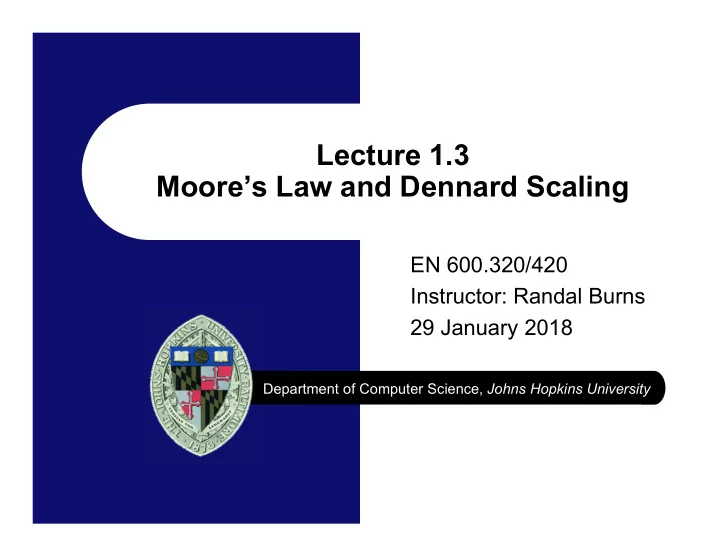

Lecture 1.3 Moore’s Law and Dennard Scaling EN 600.320/420 Instructor: Randal Burns 29 January 2018 Department of Computer Science, Johns Hopkins University
We’ve been duped! Moore’s law The number of transistors that can be – inexpensively placed on an integrated circuit is increasing exponentially, doubling approximately every two years. The observation has held for half a century – https://www.technologyreview.com/s/601 441/moores-law-is-dead-now-what/ It’s true, but not helpful: More transistors has become more cores (independent processing – units on the same chip) It’s true, but not helpful: Pipelined multicore (N k-flop cores) are not as useful as a big (Nk flop) – processor But the chip vendors tell us we have faster processors So we (the programmers) must write parallel code to make software – faster on cores with the same clock speed and number of transistors Lecture 1: Introduction to Parallel Programming
Moore’s Law Image from http://en.wikipedia.org/wiki/File:Transistor_Count_and_Moore%27s_Law_-_2011.svg Lecture 1: Introduction to Parallel Programming
Dennard Scaling As transistors get smaller their power density stays constant so that power is in proportion with area voltage and current scale downward – Performance per watt increases exponentially smaller transistors lead to faster clock rates – Dennard scaling ended in 2006 But Moore’s law still alive – Turn to multicore processors – Lecture 1: Introduction to Parallel Programming
Dennard scaling breakdown In 2006 Current leakage and heating Lecture 1: Introduction to Parallel Programming
Moore’s Law Post Dennard Scaling Moore’s law -> parallelism -> parallel programming This has already happened and software is just catching up – Is Moore’s law dead? Dark silicon, 5nm – http://www.extremetech.com/computing/165331-intels-former-chief- – architect-moores-law-will-be-dead-within-a-decade Moore’s law is dead Yes, likely, but not relevant to parallel programmers – Even if scaling does not continue, trend toward parallelism will – Lecture 1: Introduction to Parallel Programming
Discussion What are the hardware trends of note? Ubiquitous GPU acceleration – Heterogeneous/reconfigurable processing – 3-d lithography – Reduced precision processors (Google TPP) – What is the difference between cloud computing and supercomputing? What is “exascale” and why do I care? Lecture 1: Introduction to Parallel Programming
Recommend
More recommend